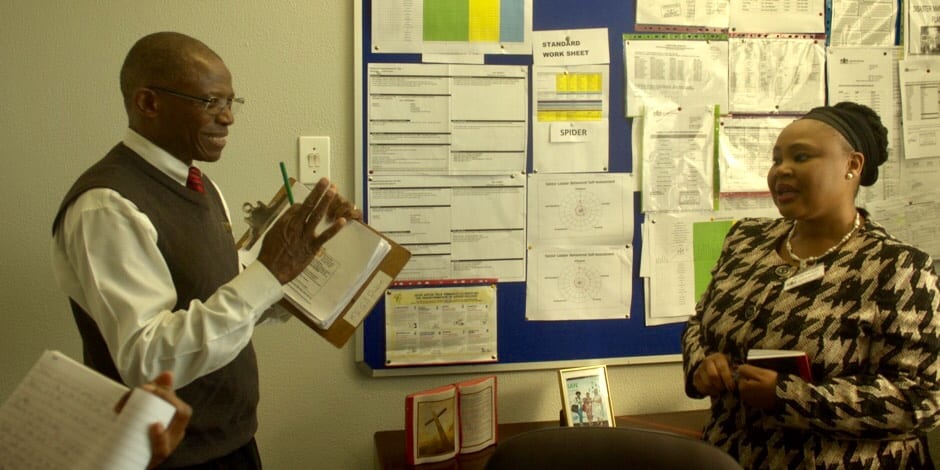
Implanting lean ideas in our practice
FEATURE – Lean thinking has helped this dental practice in Italy to streamline the work, develop the capabilities of workers and free up a lot of the head dentist’s time.
Words: Dr Moreno Cagnin, dentist and owner of Studio Cagnin, with Alessio Chemello, lean coach at Istituto Lean Management
Studio Cagnin is not your average dental practice. This is because, as owner of this middle-sized business (there is 27 of us, between employees and other dentists who also have their practice here) I have always been very interested not only in dentistry – of course, my chosen path in life – but also in management. I have always been very involved in the every-day running of the business, supported by a great team of managers.
Lean thinking is particularly intriguing in my eyes. We are not the first lean dental practice out there (have you read The Lean Dentist?), but the idea of applying lean principles and practices to such an environment is still pretty new – at least here in Italy. I was drawn to lean and decided to apply lean in the practice, because I saw it as a way to bring together my aptitude for management and continuous learning and my passion for improving the work.
Of the many lessons lean teaches us, one that has always resonated with me is the idea of making the best use of limited resources. Up until a few years ago, there is no doubt that my most limited resource was time. Back then, I was working a grueling schedule of 90 hours per week. Between seeing patients, managing my practice and studying for a new specialty in orthodontics, I was almost spending more time at my dental practice than at home.
When we began our partnership with Istituto lean Management in 2015 to learn more about the lean tools and philosophy, our coach Alessio Chemello immediately helped us to understand that we had to address my very busy schedule. My diary was constantly overflowing with appointments and meetings (remember my 90-hour week), and it was clear that starting a lean transformation in these conditions would be impossible. Time is precious, and I realized that improving my use of it could lead to very positive results for our patients and, naturally, for myself.
So, our first step was the development of an A3 titled “Save time, save money”, which aimed to optimize the use of our time while allowing the business to retain its margins.

By deeply analyzing the work in our practice, the A3 revealed that one of the reasons why I was so busy was that I had to fire-fight all the time, to tackle the problems resulting from our people lacking the necessary capabilities.
We highlighted two main problems with this: first of all, our employees lacked the technical skills to autonomously handle complex operations and activities; secondly, even though my managers and I were aware of the need to adopt a holistic, patient-based approach to running the practice, our people at the front line were not sharing that same understanding. We had to work on this discrepancy, and make our mission and vision clear to everyone working in the practice. This necessarily meant better defining and then development our organizational strategy, so that it could become a beacon for everyone working at Studio Cagnin.
To do so, we decided to deploy hoshin kanri. The diagnostic tools we used to create our hoshin were incredibly useful in making us aware of a number of things about our business that we previously didn’t know. For example, we developed a deeper awareness of our position in the market and found out we had quite a bit of competitors who were positioning themselves in our same market segment. Our product/market matrix revealed the most profitable therapies and the type of clients that wasn’t generating the desired margins.
By using the scientific method and relying on the hard data we had gathered, we were able to see a situation that was very different from our previous assumptions. This, in turn, allowed us to approach the definition of our strategy and tactics in a more informed and focused way. Among the priorities we highlighted, there were the need to develop the capabilities of people, focus our investment on certain market segments and on specific types of therapy, and try to differentiate ourselves from the competition (identifying two market segments that we could cater to from our two locations).
As our strategy became clearer and people began to interiorize A3 thinking as a way of approaching problem solving, a shift occurred in our practice: front-line staff started to own problems and process, taking on responsibilities that were once my prerogative. I guess that’s what it means to empower people!
Lean began to spread around the practice like wildfire. At the front desk, for example, staff was trained in standard work and job instructions. We also introduced a weekly report with the aim to track our performance (based on the number of visits and procedures, based on the categories we identified) and our ability to acquire new patients.
Our HR manager created a training plan to develop the capabilities of our doctors and assistants, so that they could rely less and less on my help and become autonomous in carrying out procedures (even complex ones) without compromising quality and patient care in any way.

From a financial standpoint, we carried out cost analysis for each procedure we offer, also defining a Bill of Materials (a rather peculiar tool in our sector, especially if you consider the small size of our practice). This led to the standardization of process and of material use, which previously varied based on the needs and capabilities of each individual provider.
Front-line staff at our practice has been trained in lean management and encouraged to learn how to identify waste and improvement opportunities. These are often seemingly small activities, like the review of a standard or knowledge sharing on how to interact with clients. Sharing experiences and insights allows everyone to grow faster.
Lean has reframed our activities, placing the patient at the heart of what we do and teaching us a new way of working, one that is based on teamwork and on the constant tracking of our activities, performance and results. The lean journey is never-ending: new gaps are continuously identified, and standards are constantly reviewed and improved. For this to happen, however, it’s critical that people are given a chance to grow, express their ideas and contribute their talent to our shared mission.
THE AUTHORS


Read more


INTERVIEW - Grey Dube reflects on the approach, challenges and successes of becoming a lean CEO, and on how this helped turn Leratong Hospital into a lean organization.



ARTICLE - To operate successfully we need systems, but as we grow these often give us "big company disease." The solution is bringing leadership at work level to really guarantee customer satisfaction.


SERIES – The authors discuss the final elements in their 6CON process development model – CONtinuously Improve – making and sustaining consistent improvements over time that will produce even higher levels of performance.


WEB SERIES – Episode 3 of our docuseries on lean in Brazil takes us to the second largest bank in the country. Learn how Bradesco is striving to improve its processes to provide more value to its customers using Lean Thinking.

